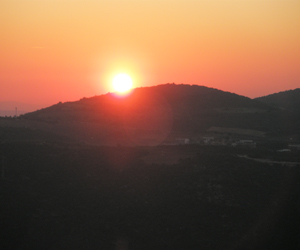Ein Zeitim
History of Ein Zeitim
Ask any local living in the Tzfat area where the best place to take the family for a picnic might be and the answer will be "Ein Zeitim". The park, built by donors who wanted to provide a safe and pleasant area for people to hike and picnic and for children to play is a favorite among residents and visitors to the area. There is plenty of wooden climbing equipment, sand piles, and swings for the kids, trails for hikers, and barbeque pits and picnic tables for those who just want to rest.
However, few people know about the history of this very special spot. Ein Zeitim, "Spring of Olives" is located about 5 miles west of Tzfat, on the road to Mt. Meron. The area was an important center of Jewish learning in the Mishnaic and Talmudic times (1st century B.C.E. through the 4th century A.D.) and many of the well-known rabbis of the times are buried in the area. Jews began to settle in the Ein Zeitim area in the 11th century, and the community thrived, at one time boasting a synagogue with 26 Torah scrolls. Many of the settlers made their livings from agriculture, including the olive groves which are plentiful in the area till today.
Throughout these years, the connection between the Jews of Ein Zeitim and those of Tzfat was strong. They were interdependent upon each other, and when hard times would affect either community, they would often take refuge among their brethren in the other. Notable among these were the earthquake which destroyed Tzfat in 1837, and Arab pogroms against both communities in 1840. After these pogroms, many Jews left Ein Zeitim, which the Jews there believed to be less defendable than Tzfat.
Modern History And Ein Zeitim
History intervened in the 1880s, when the new Zionist movement set its sights on Ein Zeitim. The Jews of Rezekne, Poland, supported settlement in Ein Zeitim, both financially and by sending immigrants who tried to establish an agricultural community there, mostly based on vineyards. Time and time again, the crops failed, mostly due to the settlers' farming inexperience, and the settlement experienced many trials. New settlers came and went, the famine of WWI engulfed the area, and finally the Arab riots of 1929 and 1936 terrorized the Jews of the community. After the civilian farmers left Ein Zeitim, the Palmach, the Jewish para-military of pre-State Israel, established a communal settlement on the site, and Ein Zeitim saw some of the fiercest fighting of the Israeli War of Independence, as the Palmach struggled to capture the area on their way to liberate Tzfat.
Even after the War of Independence, successive groups attempted to establish settlements in the area, but none was successful, and today, Ein Zeitim is a part of the Biriya National Forest. It is one of Israel's most beautiful spots, quiet and peaceful, where people gather to enjoy Israel's nature and beauty.
In a note of irony, recent years have seen the proliferation of vineyards in Ein Zeitim, the same crop that successive groups of Jewish farmers had been unsuccessful in cultivating since 1880. Today, the Ein Zeitim vineyards are known throughout Israel as providing some of the finest grapes for Israel's growing fine wine industry.

